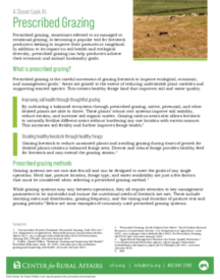Prescribed grazing, sometimes referred to as managed or rotational grazing, is becoming a popular tool for livestock producers seeking to improve their pastures or rangeland. In addition to its impact on soil health and ecological diversity, prescribed grazing can help producers achieve their economic and animal husbandry goals.
What is prescribed grazing?
Prescribed grazing is the careful movement of grazing livestock to improve ecological, economic, and management goals. Areas are grazed to the extent of reducing undesirable plant varieties and supporting wanted species. This creates healthy forage land that improves soil and water quality.
Improving soil health through thoughtful grazing
By cultivating a balanced ecosystem through prescribed grazing, native, perennial, and other desired plants are able to thrive. These plants’ robust root systems improve soil stability, reduce erosion, and increase soil organic matter. Grazing various areas also allows livestock to naturally fertilize different areas without burdening any one location with excess manure. This increases soil fertility and further improves forage health.
Creating healthy livestock through healthy forage
Grazing livestock to reduce unwanted plants and avoiding grazing during times of growth for desired plants creates a balanced forage area. Diverse and robust forage provides healthy feed for livestock and may extend the grazing season.


